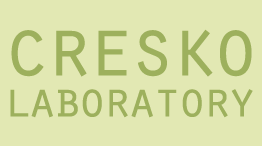
Current Research Projects in the Lab
These are some of the interest areas in our lab. It is not an exhaustive list of projects and approaches, but will give a taste of what we do and how we go about it.
Population genomics and genome evolution
Beneath the phenomena of evolutionary adaptation lies a complex lattice in which population level processes intersect with developmental and genomic constraints. The Cresko Lab explores these multilevel interactions in the threespine stickleback fish, which has many attractive advantages: countless replicate natural experiments in adaption from marine to freshwater, phenotypic radiations within a single species, examples of extremely rapid evolution on a contemporary time scale with extant ancestral populations, and genetic and developmental tractability in the lab. By richly genotyping wild populations and by generating controlled laboratory crosses, we investigate genomic signatures of natural selection, phylogeography, genome evolution and structural variation, genomic architecture, gene by environment interaction, and the genic underpinnings of adaptation. Rad-seq, a de novo genome subsampling genotyping method pioneered at UO in a Cresko and Johnson lab collaboration, made possible the use of population genetic statistics in continuous scans across the stickleback genome. This uncovers the parallel nature of genome evolution underlying parallel phenotypic evolution in stickleback populations, and reveals that a large proportion of the stickleback genome bears the signature of natural selection in replicate adaptation to freshwater from marine ancestry. In addition, building haplotype blocks from paired end RAD-seq data allows us to use coalescent approaches to investigate the age and history of genomic regions under differential selection.
Evo-devo
The evolution of development is central to questions of how old forms are modified and how apparent novelties originate. The Cresko Lab investigates the genetic basis of phenotypic evolution over shallow and deep time scales. Stickleback populations have diversified in phenotype, sometimes over very short periods (in a matter of decades). Some of the most striking of these morphological differences can be seen in comparing freshwater and marine fish, whose skeletons may differ in size, shape and the number and robustness elements. Rich variation is seen in populations where these ecotypes have interbred. Lab members are interested in tracing morphological differences in cranial bones, for example, to regions of the genome using morphometric analysis and GWAS in natural populations that vary in skeletal traits, followed by candidate gene analysis using in situ hybridization to look at gene expression during development and alteration of gene function using CRISPR. On a much deeper evolutionary time scale, we are investigating the evolution of novel morphology in the syngnathid fish, which have a derived and specialized head shape for "pipette" suction feeding, an elongated body encased in dermal armor, loss of pelvic fins, and gain (in males) of specialized, placenta-like structures for brooding embryos. We are building genomic resources (an annotated genome assembly, with an integrated genetic map, using short-read sequencing of genomic DNA and transcripts) for the study of these specializations and other evolutionary aspects of Syngnathus scovelli, the gulf pipefish.
Host-microbe interactions
Surprisingly little is known about the processes by which microbial communities populate, and persist in, host environments. This is an important problem, as recent work makes a strong case for microbial influences on many aspects of human health, such as inflammation of the gastrointestinal tract. We assume that a number of variables, including host genetic variation, differing environmental conditions, and indeterministic factors underlie variation in the microbiota among individual hosts, but understanding the relative importance of these variables and their interactions is best answered through manipulative experiments. To this end, we leverage the standing genetic variation among and within threespine stickleback populations, the ability to make gnotobiotic stickleback, and controlled laboratory studies to ask how host genetic variation influences the microbiota itself, but also host responses to microbes. Specific responses we are measuring include neutrophil influx as a proxy for inflammation in the gut, and complex transcriptional phenotypes using RNA-seq. Future work in the lab will aim to identify variants in the stickleback genome associated with variation in microbial community structure and host responses to microbes. This objective is best accomplished initially through mapping crosses and GWAS, approaches with which members of the lab are very familiar. Upon discovery of candidate causal loci and regulatory networks, we plan to perturb these systems via CRISPR mutagenesis to verify phenotypic consequences. Our work on host-microbe interactions is an integral component of the NIH-funded META Center for Systems Biology here at the University of Oregon.

